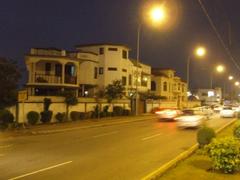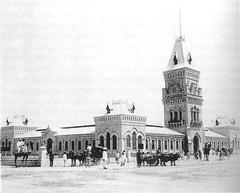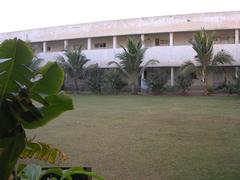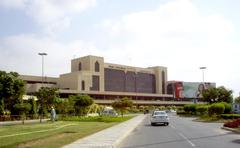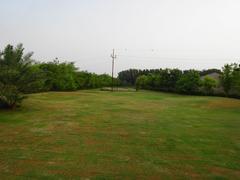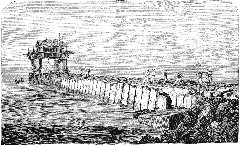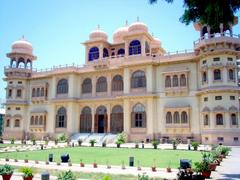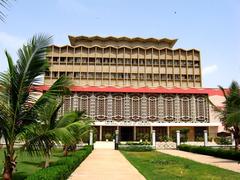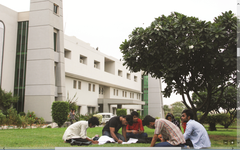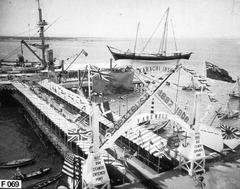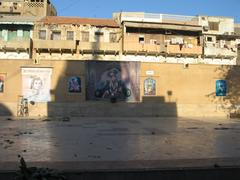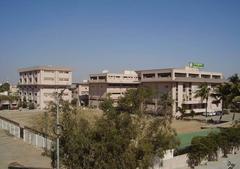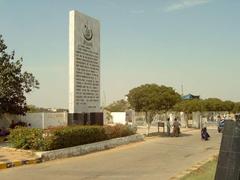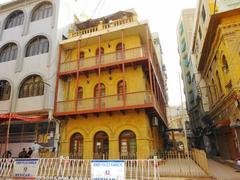
Saint Patrick’s Cathedral Karachi: Visiting Hours, Tickets, and Historical Guide
Date: 04/07/2025
Introduction
Saint Patrick’s Cathedral in Karachi is a monumental symbol of faith, resilience, and architectural splendor in Pakistan’s largest city. Originally established as a Carmelite mission in 1845 and consecrated in its present Gothic Revival form in 1881, the cathedral has served as the spiritual heart of Karachi’s Catholic community for generations. Its twin spires, pointed arches, and stunning stained glass windows crafted by Franz Mayer of Munich make it a unique landmark in South Asia. Located near Empress Market in the bustling Saddar district, the cathedral welcomes people of all backgrounds for worship, reflection, and architectural appreciation. This guide provides detailed information on the cathedral’s history, architecture, cultural significance, visiting logistics, and nearby attractions, ensuring a rich and informed visitor experience (wikiwand.com, travelertrails.com, Youlin Magazine, FlyPakistan).
Table of Contents
- Early Foundations and Origins
- Architectural Significance
- Historical Milestones and Community Role
- Cultural and Social Impact
- Preservation and Modern Developments
- Visiting Saint Patrick’s Cathedral: Hours, Tickets, and Tips
- Nearby Attractions and Photography Spots
- Frequently Asked Questions (FAQs)
- Conclusion and Practical Summary
- References
Early Foundations and Origins
Saint Patrick’s Cathedral’s roots reach back to 1845, when the first church on this site—St. Patrick’s Church—was established as a Carmelite mission under Father Casaboch. Built for 6,000 rupees, it served the growing Catholic community in Sindh, supplementing the few available worship spaces in the region (wikiwand.com). Due to increasing congregational needs, a new and larger cathedral was planned. Construction began in 1878, and the present-day structure was consecrated on April 24, 1881 (travelertrails.com). The original church was destroyed by a storm in 1885, transferring all worship activities to the new cathedral.
Architectural Significance
Saint Patrick’s Cathedral is an exemplary model of Gothic Revival architecture—a style characterized by pointed arches, ribbed vaults, flying buttresses, and dramatic verticality (travelertrails.com, source). Designed by Father Karl Wagner, SJ, and constructed with local materials, the cathedral measures 52 by 22 meters and can accommodate up to 1,500 worshippers (wikiwand.com). Its exterior features twin spires, intricate stonework, and a cruciform plan, while the interior boasts vaulted ceilings, a spacious chancel, and Franz Mayer of Munich’s stained glass windows depicting biblical scenes (trek.zone).
The cathedral’s brown brick construction sets it apart from other colonial-era buildings in Karachi, often made of yellow sandstone. Interiors are enriched by detailed woodwork, hand-carved pews, and religious artifacts, creating a harmonious blend of European design and local craftsmanship (source). In 2003, the cathedral was declared a protected monument under the Sindh Cultural Heritage Protection Act (wikiwand.com).
Historical Milestones and Community Role
As the seat of the Roman Catholic Archdiocese of Karachi, Saint Patrick’s Cathedral has been central to Christian religious and cultural life for almost 150 years (travelertrails.com). The cathedral grounds also feature the Monument to Christ the King, a marble structure commemorating the Jesuit mission in Sindh, completed in 1931 (wikiwand.com).
Key historical events include centenary celebrations in 1978, visits from dignitaries such as Mother Teresa in 1991, and rapid restoration after a bomb explosion in 1998 (wikiwand.com). The cathedral is closely associated with educational and social development through institutions like St. Joseph’s Young Girls School and St. Patrick’s High School (Youlin Magazine).
Cultural and Social Impact
Saint Patrick’s Cathedral is not just a site for worship but a beacon of Karachi’s multicultural heritage (realjourneytravels.com). The congregation is predominantly of Goan Catholic descent, reflecting the migration and cultural influence of Goan communities during the British Raj (Youlin Magazine). The cathedral hosts major religious events—including Christmas, Easter, and the feast of St. Patrick—marked by elaborate liturgies and vibrant community celebrations.
The site’s choir, historic polyphonic performances, and regular Masses foster unity and cultural richness. The “I AM KARACHI” mural across from the cathedral celebrates its role as a city landmark and symbol of interfaith harmony (Youlin Magazine).
Preservation and Modern Developments
Declared a protected monument in 2003, Saint Patrick’s Cathedral has benefited from sustained preservation efforts (wikiwand.com). The 2021 renovation, supervised by the Sindh heritage department, included roof and foundation strengthening, drainage upgrades, and restoration of stone and marble elements (Dawn). The restoration’s completion was marked by an inaugural Mass and blessings from Karachi’s Archbishop.
Recent milestones include the 175th anniversary celebration in 2018, featuring a commemorative book launch and community festivities (Good Old Karachi). Ongoing community involvement ensures the cathedral remains a vibrant center for worship, education, and social outreach.
Visiting Saint Patrick’s Cathedral: Hours, Tickets, and Tips
Visiting Hours:
The cathedral is open to visitors Monday through Saturday from 8:00 AM to 6:00 PM, and Sundays from 9:00 AM to 7:00 PM. Hours may be extended during major religious festivals.
Entry and Tickets:
Entry is free for all visitors. Donations are appreciated to support maintenance and community activities.
Dress Code and Etiquette:
Dress modestly, covering shoulders and knees. Head coverings are optional but appreciated. Maintain silence and decorum inside the cathedral, especially during services.
Accessibility:
Wheelchair access is available via ramps at the main entrance, with accessible restrooms. Staff can assist visitors with mobility needs.
Guided Tours:
Guided tours (30–45 minutes) are available on request. Contact the cathedral office in advance to schedule a tour.
Photography:
Photography is allowed, but avoid flash during services and ask for permission before photographing individuals.
Facilities:
Restrooms are available on-site. No café or gift shop exists, but Saddar offers many food and shopping options. Bring bottled water during hot months.
Location and Directions
Saint Patrick’s Cathedral is centrally located in Karachi’s Saddar district, near Empress Market and along Shahrah-e-Iraq (FlyPakistan). It is accessible by car, taxi, ride-hailing services, and public transport. Parking is limited; using nearby lots or public transport is recommended.
Nearby Attractions and Photography Spots
- Empress Market: A lively colonial-era market offering local crafts and food.
- Frere Hall: A British Raj-era building with art galleries and a Sunday book fair.
- Flag Staff House (Quaid-i-Azam House): Former residence of Pakistan’s founder, now a museum.
- Holy Trinity Cathedral: Another example of British-era ecclesiastical architecture.
- National Museum of Pakistan: Showcasing the nation’s archaeological and cultural heritage.
All these sites are within 1–2 km and easily accessible on foot or by taxi (Lonely Planet).
Best Times to Visit
The best time to visit is during Karachi’s cooler months (November to March). Early mornings and late afternoons offer pleasant weather and optimal lighting for photography. Sundays are lively with Mass, while weekdays are quieter for exploration.
Frequently Asked Questions (FAQs)
Q: What are the visiting hours of Saint Patrick’s Cathedral?
A: Monday–Saturday 8:00 AM–6:00 PM; Sunday 9:00 AM–7:00 PM. Extended hours during festivals.
Q: Is there an entry fee or ticket required?
A: No, entry is free.
Q: Are guided tours available?
A: Yes, contact the cathedral office to arrange a tour.
Q: Is the cathedral wheelchair accessible?
A: Yes, ramps and accessible restrooms are available.
Q: Can I attend Mass as a non-Christian visitor?
A: Yes, all are welcome; observe silence and respect the congregation.
Q: Are there facilities for people with disabilities?
A: Yes, but notify staff in advance for assistance if needed.
Q: Is photography allowed?
A: Photography is generally allowed; avoid flash during services and always ask before photographing individuals.
Conclusion and Practical Summary
Saint Patrick’s Cathedral stands as a testament to Karachi’s historical depth, architectural grandeur, and religious diversity. With its Gothic Revival architecture, vibrant stained glass, and rich community life, the cathedral is both a spiritual haven and a cultural landmark. Its proximity to key historical sites like Empress Market and Frere Hall enhances the visitor experience, making it an essential stop for anyone exploring Karachi’s heritage.
Visitor Tips:
- Dress modestly and act respectfully inside the cathedral.
- Plan your visit during cooler months and off-peak hours for a serene experience.
- Combine your cathedral visit with a tour of nearby attractions for a fuller understanding of Karachi’s history.
For up-to-date information on visiting hours and special events, connect with the cathedral office or check local tourism resources. Download the Audiala app for guided tours and real-time cultural insights. Follow us on social media for updates and travel inspiration.
References
- Saint Patrick’s Cathedral, Karachi – Wikiwand
- Historical Places in Karachi – Medium
- The Architectural Wonder of St. Patrick Cathedral – Youlin Magazine
- St. Patrick’s Cathedral, Karachi – FlyPakistan
- St Patrick’s Cathedral Renovation – Dawn
- A Journey of 175 Years – Good Old Karachi
- Places to Visit in Karachi – Traveler Trails
- St. Patrick’s Cathedral – Real Journey Travels
- St. Patrick’s Cathedral – Lonely Planet




